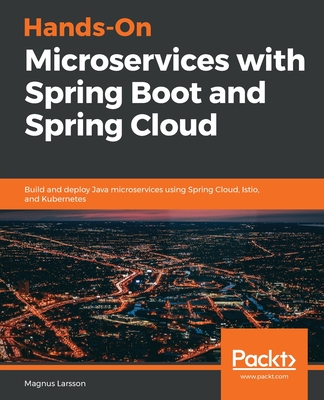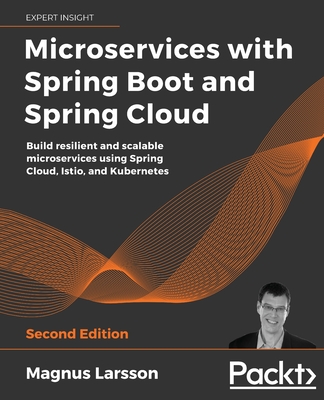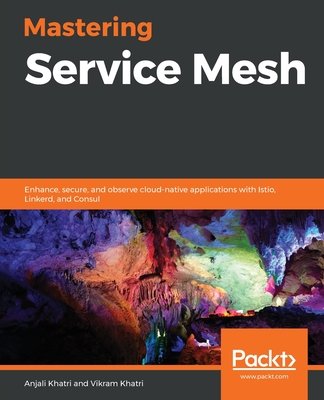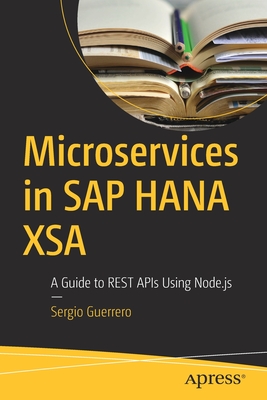Hands-On Microservices with Spring Boot and Spring Cloud
Build and deploy Java microservices using Spring Cloud, Istio, and Kubernetes
暫譯: 實戰微服務:使用 Spring Boot 和 Spring Cloud
Magnus Larsson
- 出版商: Packt Publishing
- 出版日期: 2019-09-20
- 定價: $1,980
- 售價: 6.0 折 $1,188
- 語言: 英文
- 頁數: 668
- 裝訂: Paperback
- ISBN: 1789613477
- ISBN-13: 9781789613476
-
相關分類:
Microservices 微服務、SOA、Java 相關技術
-
其他版本:
Microservices with Spring Boot and Spring Cloud - Second Edition: Build resilient and scalable microservices using Spring Cloud, Istio, and Kubernetes
買這商品的人也買了...
-
 Design Patterns: Elements of Reusable Object-Oriented Software (Hardcover)
Design Patterns: Elements of Reusable Object-Oriented Software (Hardcover)$2,500$2,375 -
 Java Persistence with JPA (Paperback)
Java Persistence with JPA (Paperback)$1,480$1,406 -
 $352人人都是資料分析師:Tableau 應用實戰
$352人人都是資料分析師:Tableau 應用實戰 -
 $454JavaEE 開發的顛覆者: Spring Boot實戰
$454JavaEE 開發的顛覆者: Spring Boot實戰 -
 資料視覺化|使用 Python 與 JavaScript (Data Visualization with Python and JavaScript: Scrape, Clean, Explore & Transform Your Data)
資料視覺化|使用 Python 與 JavaScript (Data Visualization with Python and JavaScript: Scrape, Clean, Explore & Transform Your Data)$680$537 -
 $403Python 爬蟲開發與項目實戰
$403Python 爬蟲開發與項目實戰 -
 $653SDN環境部署與OpenDaylight開發入門
$653SDN環境部署與OpenDaylight開發入門 -
 $505Spark 全棧數據分析
$505Spark 全棧數據分析 -
 7天學會大數據資料處理 — NoSQL:MongoDB 入門與活用, 3/e
7天學會大數據資料處理 — NoSQL:MongoDB 入門與活用, 3/e$520$406 -
 $327Spark Streaming 實時流式大數據處理實戰
$327Spark Streaming 實時流式大數據處理實戰 -
 $301特徵工程入門與實踐 (Feature Engineering Made Easy)
$301特徵工程入門與實踐 (Feature Engineering Made Easy) -
 Python 技術者們 - 練功!老手帶路教你精通正宗 Python 程式 (The Quick Python Book, 3/e)
Python 技術者們 - 練功!老手帶路教你精通正宗 Python 程式 (The Quick Python Book, 3/e)$780$616
相關主題
商品描述
Key Features
- Understand the challenges of building large-scale microservice landscapes
- Build cloud-native production-ready microservices with this comprehensive guide
- Discover how to get the best out of Spring Cloud, Kubernetes, and Istio when used together
Book Description
Microservices architecture allows developers to build and maintain applications with ease, and enterprises are rapidly adopting it to build software using Spring Boot as their default framework. With this book, you'll learn how to efficiently build and deploy microservices using Spring Boot.
This microservices book will take you through tried and tested approaches to building distributed systems and implementing microservices architecture in your organization. Starting with a set of simple cooperating microservices developed using Spring Boot, you'll learn how you can add functionalities such as persistence, make your microservices reactive, and describe their APIs using Swagger/OpenAPI. As you advance, you'll understand how to add different services from Spring Cloud to your microservice system. The book also demonstrates how to deploy your microservices using Kubernetes and manage them with Istio for improved security and traffic management. Finally, you'll explore centralized log management using the EFK stack and monitor microservices using Prometheus and Grafana.
By the end of this book, you'll be able to build microservices that are scalable and robust using Spring Boot and Spring Cloud.
What you will learn
- Build reactive microservices using Spring Boot
- Develop resilient and scalable microservices using Spring Cloud
- Use OAuth 2.0/OIDC and Spring Security to protect public APIs
- Implement Docker to bridge the gap between development, testing, and production
- Deploy and manage microservices using Kubernetes
- Apply Istio for improved security, observability, and traffic management
Who this book is for
This book is for Java and Spring developers and architects who want to learn how to break up their existing monoliths into microservices and deploy them either on-premises or in the cloud using Kubernetes as a container orchestrator and Istio as a service Mesh. No familiarity with microservices architecture is required to get started with this book.
商品描述(中文翻譯)
**主要特點**
- 了解建立大型微服務架構的挑戰
- 使用這本全面的指南構建雲原生的生產就緒微服務
- 探索如何在一起使用 Spring Cloud、Kubernetes 和 Istio 以獲得最佳效果
**書籍描述**
微服務架構使開發人員能夠輕鬆構建和維護應用程式,企業也迅速採用它來使用 Spring Boot 作為其默認框架來構建軟體。通過這本書,您將學會如何有效地使用 Spring Boot 構建和部署微服務。
這本微服務書將帶您了解構建分散式系統和在您的組織中實施微服務架構的經驗法則。從一組使用 Spring Boot 開發的簡單協作微服務開始,您將學會如何添加持久性等功能,使您的微服務具備反應式特性,並使用 Swagger/OpenAPI 描述其 API。隨著進展,您將了解如何將不同的 Spring Cloud 服務添加到您的微服務系統中。這本書還展示了如何使用 Kubernetes 部署您的微服務,並使用 Istio 進行管理,以提高安全性和流量管理。最後,您將探索使用 EFK 堆疊進行集中式日誌管理,並使用 Prometheus 和 Grafana 監控微服務。
在本書結束時,您將能夠使用 Spring Boot 和 Spring Cloud 構建可擴展且穩健的微服務。
**您將學到的內容**
- 使用 Spring Boot 構建反應式微服務
- 使用 Spring Cloud 開發彈性和可擴展的微服務
- 使用 OAuth 2.0/OIDC 和 Spring Security 保護公共 API
- 實施 Docker 以彌補開發、測試和生產之間的差距
- 使用 Kubernetes 部署和管理微服務
- 應用 Istio 以提高安全性、可觀察性和流量管理
**本書適合誰**
本書適合希望學習如何將現有的單體應用拆分為微服務並使用 Kubernetes 作為容器編排工具和 Istio 作為服務網格在本地或雲端部署的 Java 和 Spring 開發人員及架構師。開始閱讀本書不需要對微服務架構有任何熟悉度。
作者簡介
Magnus Larsson has been in the IT industry for more than 30 years, working as a consultant for large companies in Sweden such as Volvo, Ericsson, and AstraZeneca. He has seen a lot of different communication technologies come and go over the years, such as RPC, CORBA, SOAP, and REST. In the past, he struggled with the challenges associated with distributed systems as there was no substantial help from the software available at that time. This has, however, changed dramatically over the last few years with the introduction of open source projects such as Spring Cloud, Netflix OSS, Docker, and Kubernetes. Over the last five years, Magnus has been helping customers use these new software technologies and has also done several presentations and blog posts on the subject.
作者簡介(中文翻譯)
馬格努斯·拉爾森在資訊科技產業工作超過30年,曾擔任瑞典大型公司的顧問,如沃爾沃(Volvo)、愛立信(Ericsson)和阿斯特拉捷利卡(AstraZeneca)。他見證了許多不同的通信技術隨著時間的推移而興衰,例如RPC、CORBA、SOAP和REST。在過去,他曾面臨與分散式系統相關的挑戰,因為當時可用的軟體並未提供實質的幫助。然而,隨著開源專案如Spring Cloud、Netflix OSS、Docker和Kubernetes的推出,這一情況在過去幾年中發生了劇變。在過去五年中,馬格努斯一直在幫助客戶使用這些新軟體技術,並且也在這個主題上進行了多次演講和部落格發文。
目錄大綱
- Introduction to Microservices
- Introduction to Spring Boot
- Creating a Set of Cooperating Microservices
- Deploying Our Microservices Using Docker
- Adding an API Description Using OpenAPI/Swagger
- Adding Persisitence
- Developing Reactive Microservices
- Introduction to Spring Cloud
- Adding Service Discovery Using Netflix Eureka and Ribbon
- Using Spring Cloud Gateway to Hide Microservices Behind an Edge Server
- Securing Access to APIs
- Centralized Configuration
- Improving Resilience using Resilience4j
- Understanding Distributed Tracing
- Introduction to Kubernetes
- Deploying Our Microservices to Kubernetes
- Implementing Kubernetes Features as an Alternative
- Using a Service Mesh to Improve Observability and Management
- Centralized Logging with the EFK Stack
- Monitoring Microservices
目錄大綱(中文翻譯)
- Introduction to Microservices
- Introduction to Spring Boot
- Creating a Set of Cooperating Microservices
- Deploying Our Microservices Using Docker
- Adding an API Description Using OpenAPI/Swagger
- Adding Persisitence
- Developing Reactive Microservices
- Introduction to Spring Cloud
- Adding Service Discovery Using Netflix Eureka and Ribbon
- Using Spring Cloud Gateway to Hide Microservices Behind an Edge Server
- Securing Access to APIs
- Centralized Configuration
- Improving Resilience using Resilience4j
- Understanding Distributed Tracing
- Introduction to Kubernetes
- Deploying Our Microservices to Kubernetes
- Implementing Kubernetes Features as an Alternative
- Using a Service Mesh to Improve Observability and Management
- Centralized Logging with the EFK Stack
- Monitoring Microservices


















